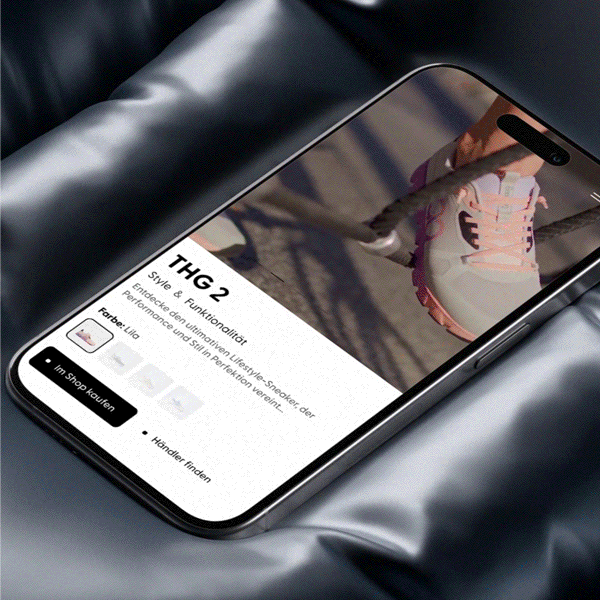Rules of Engagement
How we want to behave and communicate with each other in our day-to-day work.

Less is more
Our Rules of Engagement define the environment for successful collaboration and include rules of the engagement roadmap and tips for efficient and value-based collaboration.
The implementation of the 36-hour workweek enables a balance between work and private life. This contributes to the well-being of our employees and at the same time increases productivity throughout our digital agency.
We have opted for a 36-hour week because we know that a good work-life balance and open working hours are essential for the best performance. Together, we have developed short, medium and long-term measures that are important for a sustainable and successful reduction in working hours and ensure its success.
In our day-to-day work, we always strive to work together in a value-oriented and efficient environment.
How do we want to act in our everyday work? How do we want to communicate with each other?
There is no way around our values: they are lived and are visible and tangible in everything we do. We define ourselves as capable, friendly and curious. If you're wondering why, you can find out more about our values here.
We have defined five principles that guide us in getting the most out of our time. This includes both for customers and for our own well-being.
Five principles
01.
Standards & Knowledge Sharing
Maintaining specific standards and guidelines is the foundation of the consistently high quality of our work.
Through clear communication, the ongoing review of our processes and the willingness to learn, we enable continuous improvement, innovative solutions and personal growth - in the interest of our customers and also for our own benefit. In addition, we use proven methods and approaches and reflect on our work at the end of the day. We actively share our knowledge and experience through our existing platforms so that others can profit from it.
02.
Be focused
An efficient start into the working day and structured time scheduling ensure concentrated work and maximum productivity.
Start the day in a focused way: A good start into the workday is essential for the productivity of the team. That's why we don't schedule team meetings or discussions right at the start of the day. This gives our employees time to prepare for the day individually.
Structured through the day: By structuring the workday into defined time blocks, tasks can be processed in a targeted way and the overall daily goal can be achieved. Defined times for concentrated work without distractions from calls, e-mails or Slack messages make it possible to use working time efficiently.
Methods for new approaches: A lively exchange with colleagues about planning and approach methods always leads to new, practical insights. The following three methods are examples of this.
Methods
Urgency vs. importance (Eisenhower principle)
The Eisenhower principle is useful mainly when resources are tight.
By clearly dividing and prioritizing tasks according to importance and urgency, limited resources can be used more efficiently. This enables better time planning, optimizes workflows and helps to ensure that the most important and urgent tasks are prioritized and completed on time.
ALPEN-Method according to Lothar Seiwert
This simple method helps to keep track on tasks and make the best use of the day. After work is done, plan the following day in a few minutes:
A – Writing down tasks, appointments, and planned activities (Aufgaben)
L – Estimating length (Länge schätzen)
P – Planning buffer time (Pufferzeiten einplanen)
E – Making decisions (Entscheidungen treffen)
N – Review (Nachkontrolle)
Pomodoro technique by Francesco Cirillo
This time management method is considered to be one of the simplest and most effective. It owes its name to its inventor, the Italian entrepreneur Francesco Cirillo. He once used a kitchen clock in the shape of a tomato - a "Pomodoro". This method is particularly suitable for tasks and sub-projects that you want to complete with full focus, without distractions.
The basic principle of the Pomodoro technique is very simple:
- Select a task.
- Briefly note down what needs to be done for it.
- Set the alarm for 25 minutes and get started.
- As soon as the alarm clock rings, check off everything that has been done.
- This is followed by a break of 5 minutes, this interval is called "Promodori".
- Repeat the sequence about 4 times and then take a longer break (about 30 min).
The 25-minute intervals are a tight corset. Some tasks cannot be easily tailored to it. However, it is crucial that the basic principle, i.e. the alternation between focused work and regular breaks, is maintained.
03.
Communication is key
To prevent misunderstandings and boost teamwork efficiency, clear and transparent communication is key. It helps align expectations and fosters better collaboration.
Good communication is not an end in itself - it is the basis for trust, clarity and successful collaboration. Whether in meetings, emails or brief team consultations: we want information to flow, misunderstandings to be avoided and decisions to be comprehensible.
Feedback is a central component of our communication culture. Because only if we speak openly and honestly with each other - even about things that are not going well - can we continue to develop: as a team, as an agency and as individuals.
For us, feedback is not a chore, but an invitation to dialogue at eye level. It helps us to learn from each other, recognise potential and improve together.
Feedback culture
"Feedback is the breakfast of champions" – Ken Blanchard
Feedback works better if we introduce it correctly:
- Ask first: ‘Can I give you feedback?’
- Or: ‘Can I give you a different perspective?’
This way, the other person doesn't feel taken by surprise - and the dialogue remains open.
Make it clear why you are giving feedback:
- ‘I think feedback helps us to get better.’
- ‘I'm giving you feedback because I believe in your potential.’
And very importantly:
End your feedback with an open question - e.g. ‘What do you think about this?’
Feedback rules for ...
Giving feedback:
- Choose a good time to give feedback.
- Give feedback promptly, but never in emotionally charged situations!
- 4-eyes principle: Always give feedback without an audience!
- Give facts and be specific. Formulate I-messages instead of you-messages. And give concrete examples. Important: Describe the person's behaviour and do not judge. Describe the consequences that the behaviour has for you.
- Let the other person know what behaviour you would like to see and be open to a dialogue.
Feedback recipient:
- Take the feedback on board and listen actively.
- Ask comprehension questions if necessary and let the other person finish.
- Try not to justify or defend yourself.
- See feedback as an opportunity to learn something.
- Think about what you accept.
- Feedback is a gift, is often not taken for granted and also promotes personal growth.
Communication channels
Within the agency, we use various communication channels to keep coordination as efficient as possible. As a general rule, face-to-face coordination is often the most efficient and best way to quickly achieve optimal output.
In general, the following order usually applies:
- Personal arrangement
- Slack message / Mail
- Send out an appointment
Tools
- Slack: for direct communication with colleagues and the exchange on pixelart-wide topics and projects.
- Microsoft Teams: for remote appointments with customers and larger internal remote or hybrid appointments.
- Conference systems in the meeting rooms: for hybrid appointments, both internal and external.
- yuu Phone: Our phone software to provide phone accessibility for external callers* (clients, partners, etc.).
- Email: For internal & external communication. For messages that might be lost via the chat systems.
Kudos Cards
Kudos (from Greek: κῦδος (kydos) for glory, honor) cards are a simple but effective way to express appreciation and compliments more often in a team.
Whenever you are really proud of each other or very grateful for something, you write a few lines on the kudos card - addressed to a person or a team. These positive attentions can then be recorded "for eternity" i. ex. on an office pinboard.
Kudos cards can be used in a variety of situations - i. ex. to sweeten the start of the weekend. They serve as a small push to say "thank you" more often and create a positive impact within the team.
How to?
- Choose the right px Kudos card
- Write an appreciative message on it
- Hand over either "publicly" in a PX Townhall Meeting, or discreetly and personally
- You can also attach the card to the workplace
04.
Meet better
Basically, you can recognize a good meeting by the fact that most people in the room can answer the following questions with yes: Do I leave the meeting with more clarity? Do I leave the meeting with more energy?
Following defined ground rules in meetings is essential for successful and effective collaboration. Meeting rules ensure that our meetings are productive and goal-oriented. A successful meeting is not a matter of chance, but the result of careful planning and effective execution. In terms of who participates, we openly address who can make a relevant contribution to meeting objectives. We regularly review our meetings to ensure they are meaningful and add Value for everyone.
Roles and Responsibilities
Meeting-Owner
- Send invitation to all participants.
- Book the room.
- Communicate purpose and/or outcome expectations of the meeting to the facilitator.
- Prepare meeting setup.
- Ask participants to prepare and send documents if necessary.
- Leave room tidy and ready to use.
Facilitator
- Ensure agenda and structure are in place.
- Ensure safe entry and exit for the meeting.
- Distribute speaking time fairly among participants.
- Methodically ensure the active contribution of all participants.
- Actively demand commitment and next steps from participants.
- Document and communicate decisions.
- Ensure adherence to start and end times with timeboxing.
- Ask participants for feedback (meaningfulness, clarity & quality of the meeting)
Participants
- Fulfill the purpose of the roles performed.
- Make your own misoccupation visible and leave meetings sometimes.
- Be respectful of colleagues and avoid distractions (smartphone,...).
- Constructively and actively seek solutions.
- Communicate in a binding manner.
- Put away used material, dishes, etc.
- Support everyone in the execution of their role and point out deviations in a collegial manner.
05.
Hybrid work
While home office offers flexibility, office presence is important for team collaboration.
A schedule that all team members can follow is helpful to ensure that enough time is spent in the office to enable efficient teamwork, while also taking advantage of the benefits of the home office.
We work with a hybrid work model. Between fully-remote work and a defined attendance requirement at the agency, there is a balance that makes sense for us. The perfect mix is individual and should enable both concentrated work phases and effective and personal coordination with colleagues and clients. With Hybrid Work, our employees use the workplace that enables the best project results.
Our home base is the pixelart office. We believe in the power of personal collaboration. Because our experience has shown: The best digital solutions are often created in close dialogue. Therefore: Permanent home office or fully remote work is not in our sense. It is important to us that we are all in regular personal exchange have the possibility to meet in person. Our pixelart office remains the ideal common meeting place.

